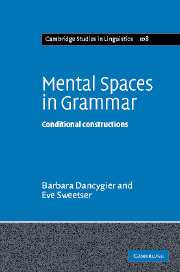Book contents
- Frontmatter
- Contents
- Acknowledgments
- Preface
- Note on abbreviated citations
- The door-scraper in the Wild Wood: an informal lesson in frame metonymy
- 1 Conditional constructions, mental spaces, and semantic compositionality
- 2 Prediction, alternativity, and epistemic stance
- 3 Tense, epistemic distance, and embedded spaces
- 4 Future and present forms in conditional constructions
- 5 Non-alternatives and alternatives: mental spaces in different domains
- 6 Then and even if: mental-space deixis and referential uniqueness
- 7 Clause order and space building: if, because, unless, and except if
- 8 Uniqueness and negative stance: only if and if only
- 9 Coordinate constructions and conditional meaning
- 10 The door-scraper in the Wild Wood: conditional constructions and frame-based space building
- References
- Author index
- Subject index
3 - Tense, epistemic distance, and embedded spaces
Published online by Cambridge University Press: 22 September 2009
- Frontmatter
- Contents
- Acknowledgments
- Preface
- Note on abbreviated citations
- The door-scraper in the Wild Wood: an informal lesson in frame metonymy
- 1 Conditional constructions, mental spaces, and semantic compositionality
- 2 Prediction, alternativity, and epistemic stance
- 3 Tense, epistemic distance, and embedded spaces
- 4 Future and present forms in conditional constructions
- 5 Non-alternatives and alternatives: mental spaces in different domains
- 6 Then and even if: mental-space deixis and referential uniqueness
- 7 Clause order and space building: if, because, unless, and except if
- 8 Uniqueness and negative stance: only if and if only
- 9 Coordinate constructions and conditional meaning
- 10 The door-scraper in the Wild Wood: conditional constructions and frame-based space building
- References
- Author index
- Subject index
Summary
“If I'd seen the machete, I'd have handled it differently.”
(Headline, Vancouver Sun, June 6, 2001)The polysemy of past-tense forms
As noted at the end of the last chapter, distanced future-reference conditionals use past-tense forms rather than future ones. Out of context, (1) could be an assessment of future eventualities, viewed with negative epistemic stance:
(1) If he decided to file the suit, the hospital's lawyers would be allowed to interview him for discovery.
However, (1) could equally well be a past narrative description of a conditional situation – a situation which was neutral in stance and future relative to the characters' situation.), only context tells us whether the past-tense verb forms are marking tense or epistemic stance. Fleischman (1989) has discussed the pervasive crosslinguistic correlation between past-tense marking and distanced stance. It has also been noted that tense marking is one of the most basic cues for relationships between mental spaces (Fauconnier 1985 [1994], 1997; Cutrer 1994; Mejías-Bikandi 1996).
In Example (2) there is no ambiguity. The conditional presented is in past-tense form not because it is distanced epistemically, but because it is embedded in a past-tense narrative space.
(2) The gun had dug a deep bruise into my side when I tumbled from the boxcar. I'd be sore for four or five days, but if I was careful I'd be okay … Lotty dispensed that verdict at her clinic Sunday afternoon …
(SP. HT.233)- Type
- Chapter
- Information
- Mental Spaces in GrammarConditional Constructions, pp. 56 - 79Publisher: Cambridge University PressPrint publication year: 2005



